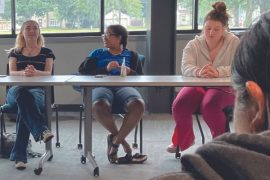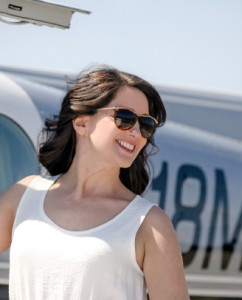By Katy Macek | Photographed by Shanna Wolf
When we’re young, many of us are taught that success is about making it to the top of our career or raising a family—or both.
What no one tells us about is what happens after we’ve reached those pinnacles. What comes with the winding down of life, after the kids are launched and after retirement?
Several women in the Madison area are grappling with that very question and think the answer lies in something they gleaned when they were kids; art, in any of its various forms, or perhaps even simpler, a creative outlet, can be an engine for contentment.
Therapeutic art
Denny Geller, 78, is an art therapist who worked more than 20 years at Madison’s Oakwood Village retirement community. She retired in 2014 but still leads a knitting as art therapy group there every week.
“Art is another way of calming the mind and giving yourself the opportunity to look at the world in a more significant way,” says Geller. “You talk about keeping the brain active and watching growth, and you watch people walk with a snappier step. It’s all about the opportunity to learn and to maybe do something you never did before.”
Geller’s group is geared toward Oakwood Village’s independent living community, but she says anyone is welcome. Group members work on scarves, mittens, hats and prayer shawls.
Many of their creations are donated to various causes. Last year, Geller says, they gave away more than 300 items to five different organizations.
Geller went back to school for her undergraduate degree when she was 50. She then earned a master’s degree in art therapy. But she’s been an active artist since she was a little girl, doing everything from crafts to painting and ceramics to her most recent endeavor, creating dolls.
As Oakwood Village’s art therapist, she worked with clients in groups and one-on-one, using art to explore how they were feeling. The process can be as simple as drawing a picture or making a collage of photos from magazines. She also held knitting groups for independent living, assisted living, the nursing space and Alzheimer’s patients.
“I had 85-, 88- and 89-year-old women looking at knitting patterns,” Geller says. “People come when they’re in pain physically and in pain mentally, and they work it out on those needles.”
Geller says she’s seen countless benefits that art therapy has had on everyone, but especially seniors, including improved health, a more comfortable view on life, an opportunity to talk openly about loss and pain and a relaxing creative outlet to fill the time.
But it doesn’t have to be just creating art, she says. Anything that incorporates creativity will help.
“What is that form for you? It could be the physical creation of art,” she says. “It could be listening or learning new music. It could be going to a play or visiting a museum.”
What it comes down to is finding new and creative ways to work your brain. Because people who “retire and then sit down in a chair don’t live very long beyond that,” Geller says.
Across town, two women are finding that to be true as well. And they want to help anyone and everyone around them by being that outlet.
Unlocking creativity
On a mission to inspire and empower, Catherine Quint, 73, and her friend Patti Fellenz, 69, set out to create one-of-a- kind art workshops focused on repurposing discarded objects.
“There’s so much in your head that has been locked up because of work and raising children and all these things that get in the way,” Quint says. “So, what we’re trying to do is open up that world for people.”
The two lead art workshops once a month at Yahara Bay Distillery in Madison, which Quint co-owns, or at the business’s former location at 3118 Kingsley Way. The venue depends on what kind of materials they’re going to be using. Quint says they tend to focus on art made out of natural materials or repurposed items. The idea is to get people thinking creatively.
May’s workshop, for example, will be furniture making. The two provide all of the materials—as well as wine and snacks—and will do basic demonstrations. But each student is allowed to create whatever they want from “any piece of furniture we have to offer,” Quint says.
Quint says her students range in age from 30s to 60s, but classes are open to anyone. Each class starts with a demonstration and perhaps some conversation about the students’ lives. Quint, a retired art teacher, says she likes to give students permission to forget about whatever else has been going on that day and just focus on creativity for the duration of the class.
Quint says that she and Fellenz have learned over the years that the most important thing for many women to do is take time for themselves. Especially after the kids are grown and life has shifted, both agreed it’s important to come to terms with where you are and then make a plan. Because life is difficult, and it’s easy to get buried in it. But Quint says that’s not an excuse to not make time for yourself.
“Between the two of us, we have had abusive husbands, both physical and emotional, alcoholism, suicide, we’ve had joint replacements, lung cancer, breast cancer and a variety of other sundry things and we’re here doing this fun stuff,” Quint says. “You can’t get through life without pain. Maybe that’s why you have to be our age to do what we’re doing.”
Quint taught two- and three-dimensional art at the middle and high school levels for seven years, but Fellenz says she has no formal artistic background. She was a case manager at Marc Inc., serving people with developmental disabilities, when she noticed that Yahara Bay had a gallery.
Knowing that several of her clients had artistic talent, she struck up a conversation with Quint and a partnership was born.
And Yahara Bay’s first-ever art show featured Fellenz’ photography—a hobby she picked up to help women with cancer find a way to express themselves.
She’s not doing it for the money, but rather to help empower women.
“It doesn’t cost me anything except my time, and that’s OK, and listening to their stories,” Fellenz says. “That’s what I like to do.”
Quint says that’s what Fellenz does at the art workshops, too.
The other benefit of their unique workshop setup, Fellenz says, is that it allows them to get to know the students and for them to get to know each other.
“When people leave this place, we’re hoping they leave with what they gained here,” Quint says. “And think about it and apply it in other ways. I think that’s happening, or they wouldn’t be coming back.”
That is true for Artis Schulenberg, who has attended several of the art workshops.
“Every month it’s something different, and it’s relaxing with a bunch of nice women,” Schulenberg says. “None of us are great artists or anything. It’s just fun. You have a drink, you sit down, you laugh and you create something in the end that you can be proud of.”
And those feelings extend beyond the workshops. She says she finds herself being more creative and thinking about objects with a new perspective.
After taking a workshop on rocks covered with fabric, Schulenberg decided to take those new ideas further and is in the process of setting up a class at her church on the same project.
Though she’s never done something like that before, she says the class inspired her to pay it forward.
“That was something that was easy, yet fun, and you create something kind of unique,” Schulenberg says. “I thought I could share that with another group of people.”
The workshops, Fellenz says, are about helping people, especially women, feel confident in themselves. A former carpenter, Fellenz says she likes to incorporate power tools into many of the classes. From sanding to saws, she’s taught women how to use carpentry tools. She hopes that translates into the students feeling more in control of their own lives.
“I think first we empower the women,” Fellenz says. “Once they have the power, they seem to grow and thrive and blossom into something.”




